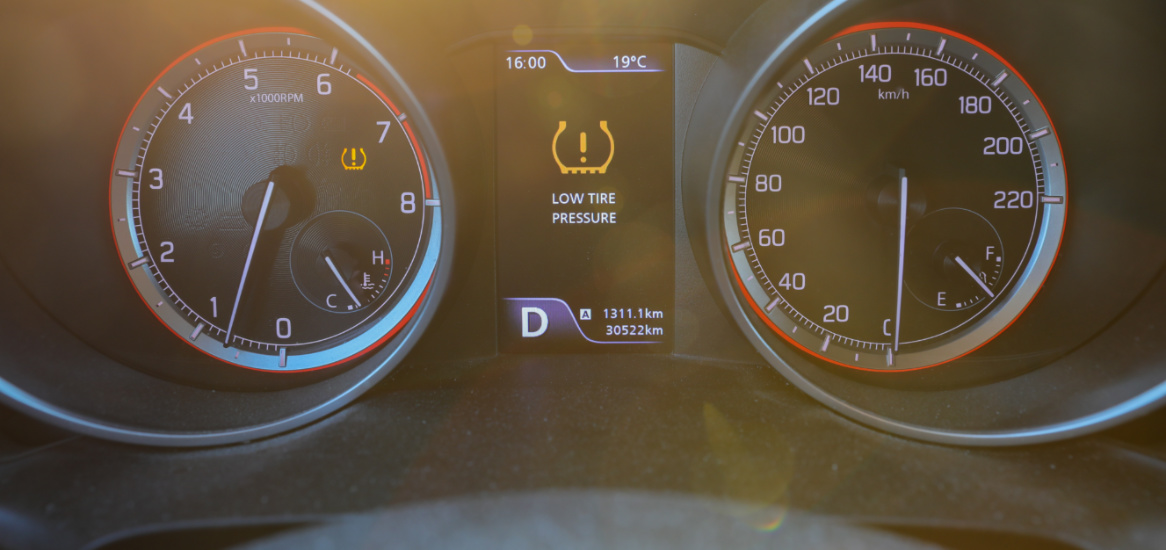What causes the tire pressure light to come on?
In most cases, when your tire pressure warning light comes on, it means your tires are below ideal pressure and need to be inflated. However, it can also mean a few different things, depending on how the light behaves and how often and how long it’s lit up. Knowing what causes the specific behavior of the TPMS warning light can help you fix it and get your car running smoothly and safely again.
TPMS works by taking signals from sensors in the wheels and sending them through the vehicle’s on-board computer. If the tire pressure is too low, the TPMS warning light will illuminate to warn you that your vehicle’s tires need to be inflated. Knowing the most common causes of tire pressure warning lights and how to fix them can help you maintain your tires and stay safe on the road.
When it comes to vehicle components, tires are probably one of the most important. Making sure your tires are in good condition and inflated to the proper pressure is essential to responsible car ownership. Tire pressure lights, also known as TPMS or tire pressure monitoring systems, warn you if there is a problem with your tires.
What to do if tire pressure is low…
stay lit
If the TPMS light stays on, it means the tire pressure is too low or too high. Too much pressure is rare, but it can happen if you recently did an oil change and the technician ran the pump too high, or if you did it yourself and added too much air. It’s easy to fix by pressing the small pin in the middle of the stem to let the air out.
If the tire pressure is low, you will need to take it to a car service station and use an air compressor to inflate the tire. If you need to do this on a regular basis, it’s a good idea to bring your car to a tire center and have them check for slow leaks.
toggle on and off
Sometimes the tire pressure is on the borderline between correct and too low. When this happens, the pressure can go up and down intermittently due to changes in temperature and road conditions. A tire pressure sensor only sends a signal to turn on the light if it falls below the recommended level. When the pressure level returns, the light will go out.
One of the main reasons this happens is the fact that cold weather can affect tire pressure. As the temperature drops, the tire’s PSI can drop as air tends to contract. In such cases, it is advisable to inflate the tire sufficiently so that it reaches the ideal pressure when cold. This keeps the lights off and he can be sure the tires are at the right PSI throughout the day.
flashing light
Blinking tire pressure lights aren’t as common as other types of warnings, but they can happen from time to time. A blinking tire pressure warning light usually means that there is a problem with the TPMS system. Loose wires, worn sensors, or malfunctioning on-board computers can all cause problems with your system.
If the TPMS light is flashing, take the car to a service center and have it looked at. If there is a problem with the car’s computer, it can cause malfunctions in other parts of the car if left unattended for too long. Additionally, there’s no way to know that your tires aren’t inflated to the proper PSI unless you manually check them with a pressure gauge.
How to fix the problem turning on the tire pressure light
Depending on why your low tire pressure warning light is on, there are several ways to fix the root cause and turn it off. In general, if you don’t know why the light stays on, your best bet is to bring the vehicle to a tire center. They can run tests and let you know if your car is safe to drive as is or if it needs a more comprehensive repair.
Inflate tires:
In most cases, a lit TPMS light simply means that your car tires need to be inflated. This can be done at most gas stations as long as they have an air compressor. The compressor has a tire pressure gauge that shows the current pounds per square inch of the tire. Check your owner’s manual or tire sidewall if you are unsure of the correct location. Inflate a little at a time to avoid over-inflating the tire.
If you’ve added water to your tires and the lights are still on, it could indicate a problem with your TPMS system. However, depending on the vehicle, the light may not turn off if the vehicle is not driven for a while. The owner’s manual should explain the process so you can feel at ease when behind the wheel.
Rotate the tires:
Uneven tire wear can cause tire pressure sensors to turn on. In such cases, take the vehicle to a tire center and have it rotated. Tire rotation requires moving the tires to different locations on the vehicle so they don’t wear out in different locations and cause baldness.
The advantage of bringing the vehicle in for a tire rotation is the fact that the technicians there will look at the tires and make sure they are in good condition. We can fix even the smallest punctures and leaks, so you can be confident that your vehicle is safe to drive. Technician turns off his TPMS lights if necessary.
Change tires:
As tires reach the end of their life, they may lose their airtightness. Whether this is a bald spot or a small leak, your tires may not be as leak-proof as they used to be. It may be time to invest.
Replace TPMS sensor.
The sensors that check tire pressure are typically located in fairly remote locations, but are exposed to tons of road dust and debris. Because of this, it may need to be replaced from time to time. If the tire pressures are correct but he keeps the TPMS lights off, you may have a sensor problem.
Replacing the sensor is fairly simple, but should be left to a certified tire technician. Not only can they replace the sensor, they will also check for other issues with the vehicle’s computer. This way you can be sure that the sensors are working and that they are giving you accurate information about your tires.
How to turn off the tire pressure light
In most cases, the TPMS warning light will go out as soon as the tire pressure is at the correct level. However, it can be miles before the sensor gets the correct reading to your computer. You may also need to press the reset button on the dashboard. It depends on your vehicle, but it’s usually found in the owner’s manual.
In some cases, the vehicle’s computer needs to be reset before the TPMS light turns off. To do this, you need to disconnect the negative terminal from the vehicle’s battery for about 30 seconds. Then, once reconnected, you’ll need to drive a few miles on the highway so the computer can run all the checks. However, this is not always the case. That’s why it’s so important to have your owner’s manual handy.
Why is my tire pressure too low?
The reasons for low tire pressure depend on the type of driving and the type of vehicle. Eventually the TPMS light will come on and you will need to inflate your tires. Knowing some of the most common causes of low pressure can help you decide if you need to take further action.
Tire wear:
As tires start to wear out, they become less airtight than they were when you first bought them. This can be caused by air leaking between the tire bead and rim, or small holes when the tread begins to wear. Either way, a steady TPMS light could indicate that it’s time for new tires.
temperature:
Temperature can have a big effect on tire pressure. Generally, for every 10 degrees of temperature drop, tire pressure drops about 1 PSI. This is because the air inside the tire expands when it gets hot and contracts when it cools. Because of this, you may notice that the TPMS lights are only on in the morning and off in the afternoon.
time:
No matter how well you maintain your car, sooner or later your tires will lose some air pressure. The air tries to find tiny cracks in the tire that eventually fade away over time. This is why we see punctures in cars that have been sitting for a long time. Even if you drive your car every day, at some point you will need to inflate your tires.
punk:
Punctures are a major cause of tire pressure being too low. No matter where you are driving, there is all kinds of debris and debris on the roads. Nails, screws, shards of glass or metal, and sharp rocks can all puncture your car’s tires. Every time you inflate a tire, check the tire for holes or something stuck and allow the air to escape.
How to find the correct tire pressure for your car
Not all tires need the same PSI when inflated, but most passenger cars need somewhere between 32 and 35 PSI. However, you should check and confirm before you consider this to be suitable for your vehicle. This will help you avoid TPMS warning lights and other serious problems such as punctures and punctures.
Tire sidewall:
One of the most common locations for recommended PSI on a vehicle is the tire sidewall. This is printed in raised letters on the side of the tire to indicate his recommended PSI range for that particular tire. If you have aftermarket tires on your vehicle, this is the most authoritative source for recommended pressures.
operating instructions:
Your vehicle’s owner’s manual will list the recommended tire pressures for the vehicle’s original tires. However, it’s important to remember that if you put different tires on your car than they originally came with, you may need different pressures. The owner’s manual also has important information such as how to reset the TPMS warning light and what the different flashes and blinks mean on certain cars.
door sticker:
Newer cars have a sticker on the driver’s side door jamb with all sorts of important information. This sticker lists his recommended PSI as well as the size and type of tire that came with the vehicle. As with the owner’s manual, this sticker may not contain the correct information if aftermarket tires are fitted to your vehicle. Because of this, you should double-check your tire sidewalls for proper PSI.
final thoughts
A tire pressure warning light is a great way to make sure your tires are safe when you’re behind the wheel. Understanding how to interpret this light and what it means will ensure that your tires are always properly inflated and you won’t experience any issues on the road. Knowing what the lights mean and what comes on gives you peace of mind knowing that you have a solid grip on the road and that you can rely on your vehicle.
https://www.autolist.com/guides/what-your-tire-pressure-light-means What the tire pressure lights mean










